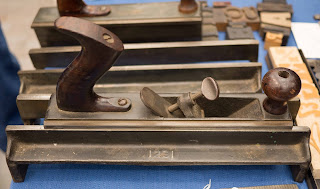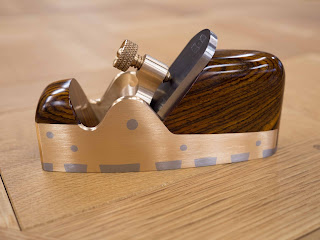This past weekend, Joe Steiner and I traveled to Pickering Ontario for the spring
Tools of the Trade show. This is the first time in at least 10 years that we did not set up as vendors but rather just as attendees. I have to say - it was a lot of fun! I am always overwhelmed by the sea of antique tools and no matter how hard I try to concentrate, I miss stuff. This year was a little different, and I wonder if it is because I had my camera with me and could ‘see’ through a different lens so to speak. Regardless of why it was different - it was, and I had a lot of fun seeing more and catching up with old friends.

There was a pretty cool infill with a particularly contemporary front bun. The traditional form of the front bun does not stray too much, so seeing examples like this is a real treat. Sadly, it did not strike me as an overly comfortable plane - I wish there would have been a bench to try it out. Things are different when you stand there holding a plane vs place it on a piece of wood. I have made that mistake in the past, and have learned not to pass judgement until I can actually try it.
A striking lever cap.
Frank Flynn had a pair of typesetters planes. These took me back to my previous life as a graphic designer. These are planes for re-surfacing wood type. What was new to me was seeing one of them outfitted with a Disston file for working endgrain type. I was tempted, but held off, and I am glad I did - the real prize of the show was just around the corner.
Both planes ride in a track to ensure consistency of thickness. Examples of wood type below.
I had a chance to catch up with
Darryl Gent as well. He is a planemaker from Welland Ontario and showed me this sweet spalted European Beech smoother. He has soaked it in oil which has added to the weight. Really nice work.
I also had a chance to catch up with my friend Anson. He had a table full of Japanese tools - mainly hammers and saws.
There was one hammer in particular that caught my attention right away. I couldn't believe it - a little brother to a
hammer from years ago. I immediately picked it up and did not put it down until I had decided. Needless to say, it came home with me, and I think I will re-handle both of them at the same time. The other handle has a small crack right below the head. I keep a close eye on it, but don't want it breaking off when I am working. The hard part will be deciding on the handle material. Suggestions?
Can you guess which one it is?
I also have a spare XSNo.4. I just completed these 2 planes. The one in the back is spoken for - it was the original commission. There were 2 matching sets on the shelf so I decided to make both of them. I am working on a 24" jointing plane right now, and working on these 2 much smaller planes has been a nice break from such an intense plane.
The plane is 5-1/2" long, has 52.5 degree bed angle, bronze sides, lever cap and screw. The infill is an unknown Rosewood - I suspect a close relative of Cocobolo, but I am not 100% sure. The blade is high carbon steel from Ron Hock. The top photo is more accurate for color - it is pouring rain right now so the balcony ledge is unavailable. A
Versailles pattern parquetry floor panel will have to do.
The price is $1,750.00 Cdn + actual shipping cost and insurance if desired. Send me an email if you are interested. konrad@sauerandsteiner.com
































7 Comments:
They look great! I was wondering how long they would take to acclimatize. I can't remember whether you have mentioned it or not - do you have a dehumidifier kiln? If you don't, (or do) how much would you use it? I know you're not one to rush seasoning!
Those are beautiful, Konrad. And to find one in the wild like that? Oooh man, you must have some good Karma built up!
Can't wait to see the next step. But... I suppose we'll have to wait a bit, won't we?
Ah, well.
Hi Owen,
I do have a dehumidification kiln, but have not used it in some time. I really prefer to just give things time. And, at the rate that I go... things seem to get more than enough time to dry all on their own. That being said, they are pretty small pieces now and (fingers crossed) should dry fairly quick.
cheers,
konrad
Yeah Ethan - we are going to have to wait. I think I drained the Karma reserve for this one... I can't believe I found it... and that nobody else bought it before I did.
cheers,
konrad
This feels like a stupid question, but what are these hammers used for? It would seem that by using a curved handle one end of the head is being taken out of use. Are they reversible?
Hi Kevin,
Not a stupid question. I used the larger hammer for all sorts of tasks. I used it to install my herringbone floor, I have used it when tapping furniture parts together, I have used it with a chisel. The curve I have roughed out is a little more extreme than I hope the final shape will be - but a gentle curve is nice. The boxwood handle was curved as well and the curve told me which face was facing which direction. One end of the hammer head is flat, the other is domed.
cheers,
konrad
Nice job, wood polisher. Quick question: will these hammers work with corded nails?
Post a Comment
Subscribe to Post Comments [Atom]
<< Home